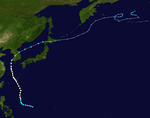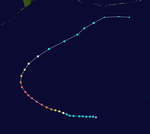| 1952 Pacific typhoon season | |
|---|---|
 Season summary map | |
| Seasonal boundaries | |
| First system formed | May 5, 1952 |
| Last system dissipated | January 4, 1953 (record latest) |
| Strongest storm | |
| Name | Wilma |
| • Maximum winds | 295 km/h (185 mph) (1-minute sustained) |
| • Lowest pressure | 893 hPa (mbar) |
| Seasonal statistics | |
| Total storms | 29 |
| Typhoons | 20 |
| Super typhoons | 6 (unofficial) |
| Total fatalities | 1,070 |
| Total damage | Unknown |
| Related articles | |
The 1952 Pacific typhoon season had no official bounds, but most tropical cyclones tend to form in the northwestern Pacific Ocean between June and December. These dates conventionally delimit the period of each year when most tropical cyclones form in the northwestern Pacific Ocean.
The scope of this article is limited to the Pacific Ocean, north of the equator and west of the international date line. Storms that form east of the date line and north of the equator are called hurricanes; see 1952 Pacific hurricane season. Tropical Storms formed in the entire west Pacific basin were assigned a name by the Fleet Weather Center on Guam.
YouTube Encyclopedic
-
1/3Views:4 01662721 160
-
TIMELINE: DEADLIEST TYPHOONS that HIT Philippine Area of Responsibility (PAR) Since 1617
-
1929 Atlantic Hurricane Season Animation
-
Cruiser Bow Ripped Off By Typhoon 1945 Newsreel
Transcription
Season summary

Systems
Typhoon Charlotte
Typhoon Charlotte formed on June 10, near the Philippines. It then strengthened and made landfall as a minimal typhoon near Hong Kong before dissipating on June 15.
Typhoon Dinah
On June 23, Dinah struck to the west of the Kanto Region in Japan. 65 people were killed and 70 were missing.[1]
Typhoon Emma
Typhoon Emma hit the Philippines and South China, especially Hainan Island.
Tropical Storm Freda
Freda weakened to a tropical depression before hitting Kyushu.
Tropical Storm Gilda
Tropical Storm Gilda hit China as a tropical storm.
Typhoon Harriet
Harriet hit China as a Category 3 typhoon, with winds of 115 mph (185 km/h).
Tropical Storm Ivy
Tropical Storm Jeanne
Typhoon Karen
Typhoon Karen struck land, mostly Korea and Japan.
Typhoon Lois
Typhoon Mary
Typhoon Nona
Tropical Storm 12W
Typhoon Olive
The strongest Pacific typhoon in 1952, Olive developed about 1,600 mi (2,600 km) southwest of Honolulu, Hawaii on September 13. The next day, the system intensified into a tropical storm. Rapidly intensifying, Olive became a typhoon on September 15. The next day, Olive strengthened into a Category 5-equivelant cyclone on the modern-day Saffir–Simpson hurricane wind scale. Olive weakened into a Category 2 typhoon before recurving northeast. On September 19, the cyclone weakened further, becoming a severe tropical storm. it then transitioned into an extratropical cyclone and was last monitored on September 21.[2]
Olive produced significant damage on Wake Island, where wind gusts reached 142 mph (229 km/h). Significant flooding was reported, and the majority of the structures were destroyed. However, few injuries were reported, and the island's facilities were restored the next year. Typhoon Olive remains one of the most intense tropical cyclones to affect the island.
Tropical Storm 14W
Typhoon Polly
Typhoon Rose
Tropical Storm Shirley
Shirley tracked through Vietnam. Shirley weakened to a tropical depression before hitting Vietnam.
Typhoon Trix
Typhoon Trix was a deadly typhoon that struck the Philippines as a Category 3 typhoon. It struck the Bicol region, killing 995 people.[3]
Typhoon Vae
After striking Vietnam, Vae crossed over to the North Indian Ocean before dissipating.
Typhoon Wilma
On October 26, ten people were lost when a USAF WB-29 disappeared during a flight into Super Typhoon Wilma.[4]
Typhoon Agnes
Typhoon Agnes was a strong Category 5 that stayed out to sea without causing much impact to land.
Typhoon Bess
Typhoon Carmen
Typhoon Della
Typhoon Elaine
Typhoon Faye
Typhoon Gloria
Typhoon Hester
Typhoon Hester remained in the open sea. Despite this, Enewetak Atoll experienced severe flooding..
Storm names
|
|
|
See also
- 1952 Pacific hurricane season
- 1952 Atlantic hurricane season
- 1952 North Indian Ocean cyclone season
- Australian region cyclone seasons: 1951–52 1952–53
- South Pacific cyclone seasons: 1951–52 1952–53
- South-West Indian Ocean cyclone seasons: 1951–52 1952–53
References
- ^ Digital Typhoon: Disaster Information
- ^ Joint Typhoon Warning Center. "1952 Joint Typhoon Warning Center "best track" data". National Oceanic and Atmospheric Administration. Retrieved January 18, 2009.
- ^ "::..Typhoon2000.com: 30 Worst Typhoons of the Philippines (1947-2002)..::". Archived from the original on 2009-03-17. Retrieved 2015-06-09.
- ^ Deadly Hurricane Hunter Flights




































